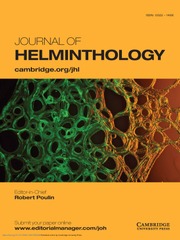No CrossRef data available.
Article contents
Never ending diversity: two new species of the genus Allocreadium (Digenea: Allocreadiidae) including new keys to the genus
Published online by Cambridge University Press: 28 October 2024
Abstract
Two new species of the genus Allocreadium were isolated from the intestines of the Lake minnow Rhynchocypris percnura caught in the backwater of the Komissarovka River in the South of the Russian Far East. The morphology of A. anastasii n. sp. corresponds to that of Allocreadium sp. from Lake Khar (Mongolia) and Allocreadium sp. Belous, 1952 from the Primorsky region of Russia except for the preacetabular anterior border of the vitelline follicles in A. anastasii n. sp. from the Komissarovka River vs. at anterior half of ventral sucker in Allocreadium sp. Genetic analysis revealed the identity of A. anastasii n. sp. to Allocreadium sp. 1 from the Nezhinka River and Lake Khar. Allocreadium macrolecithum n. sp. was differentiated from Palaearctic Allocreadium spp. by having the following features: respectively large vitelline follicles extending from posterior extremity to anterior margin of the ventral sucker; relatively short caeca reaching the border of middle and posterior thirds of hindbody; and small testes in the middle of hindbody. Interspecific genetic p-distances between Allocreadium spp. were 0.16–7.23% in 28S gene and 18.62–31.54% in Cox1 mtDNA gene. In the phylogenetic tree reconstructed with Maximum parsimony and Bayesian Inference methods, A. anastasii n. sp. and A. macrolecithum n. sp. were nested into different species groups of the genus Allocreadium – sister to A. khankaiense and A. bursense, respectively. Modified dichotomous keys were prepared for 31 Palaearctic species of Allocreadium including A. crassum, A. dogieli, A. papilligerum, A. bursense, A. anastasii n. sp., and A. macrolecithum n. sp.
- Type
- Research Paper
- Information
- Copyright
- © The Author(s), 2024. Published by Cambridge University Press


